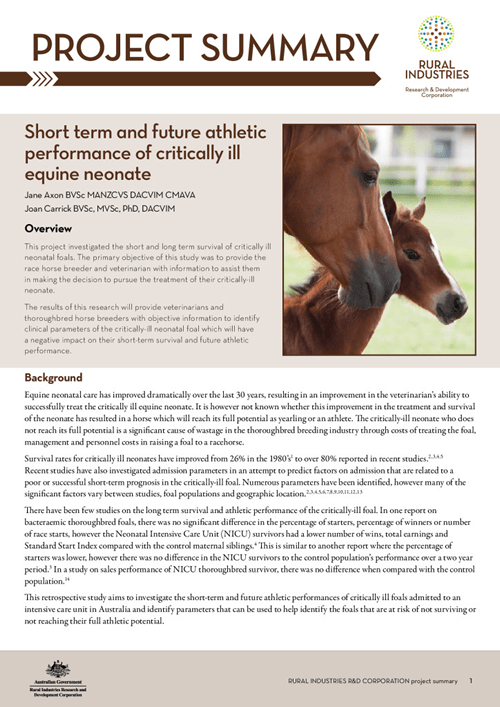Fact sheet: Equine herpes virus
Equine herpes virus (EHV) is a DNA virus found in horses all around the world. There are different strains of EHV, with the most common...
 THOROUGHBRED HORSES
THOROUGHBRED HORSES 
Published: 21 Sep 2015
Author(s): Axon, Jane, Carrick, Joan B
Download report PDF
DownloadEquine neonatal care has improved dramatically over the last 30 years, resulting in an improvement in the veterinarian’s ability to successfully treat the critically ill equine neonate. It is however not known whether this improvement in the treatment and survival of the neonate has resulted in a horse which will reach its full potential as yearling or an athlete. The critically-ill neonate who does not reach its full potential is a significant cause of wastage in the thoroughbred breeding industry through costs of treating the foal, management and personnel costs in raising a foal to a racehorse.
Survival rates for critically ill neonates have improved from 26% in the 1980’s to over 80% reported in recent studies. Recent studies have also investigated admission parameters in an attempt to predict factors on admission that are related to a poor or successful short-term prognosis in the critically-ill foal. Numerous parameters have been identified, however many of the significant factors vary between studies, foal populations and geographic location.
There have been few studies on the long term survival and athletic performance of the critically-ill foal. In one report on bacteraemic thoroughbred foals, there was no significant difference in the percentage of starters, percentage of winners or number of race starts, however the Neonatal Intensive Care Unit (NICU) survivors had a lower number of wins, total earnings and Standard Start Index compared with the control maternal siblings. This is similar to another report where the percentage of starters was lower, however there was no difference in the NICU survivors to the control population’s performance over a two year period. In a study on sales performance of NICU thoroughbred survivor, there was no difference when compared with the control population.
This retrospective study aims to investigate the short-term and future athletic performances of critically ill foals admitted to an intensive care unit in Australia and identify parameters that can be used to help identify the foals that are at risk of not surviving or not reaching their full athletic potential.